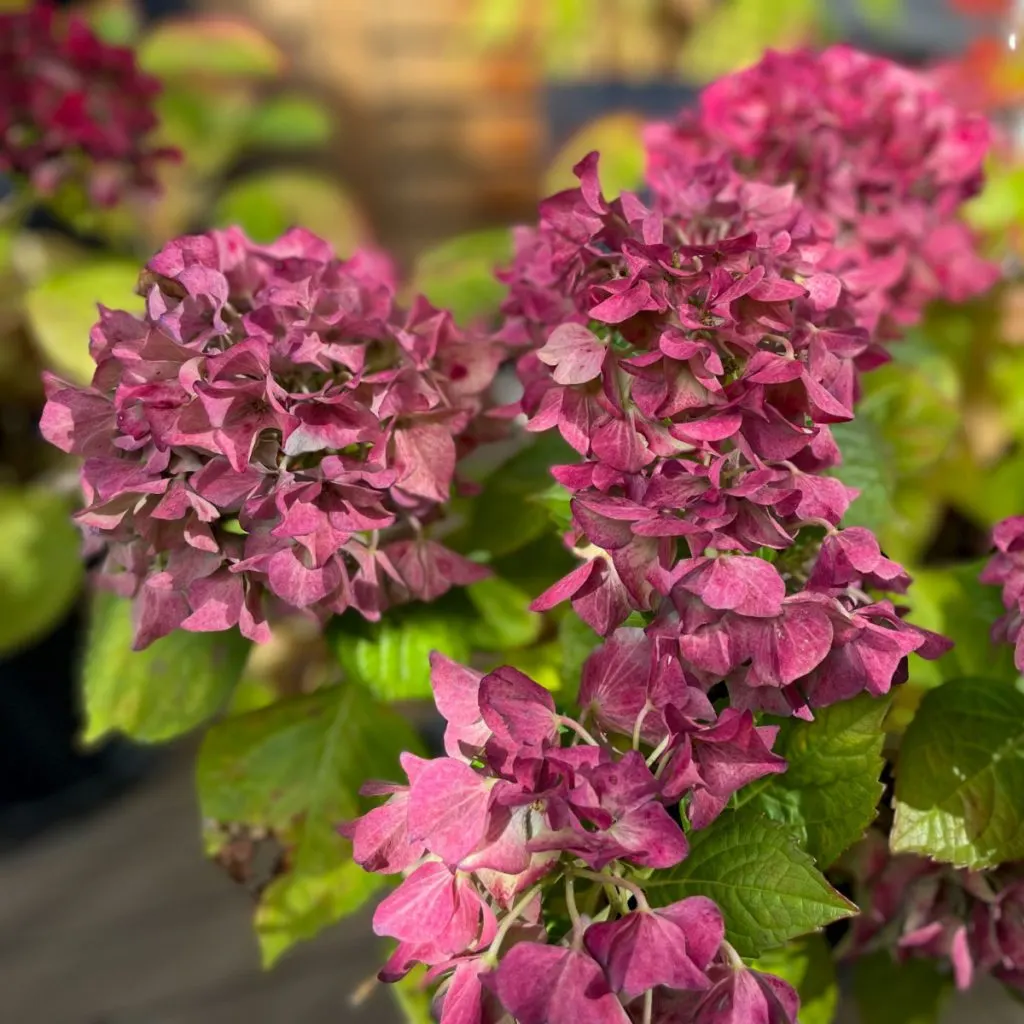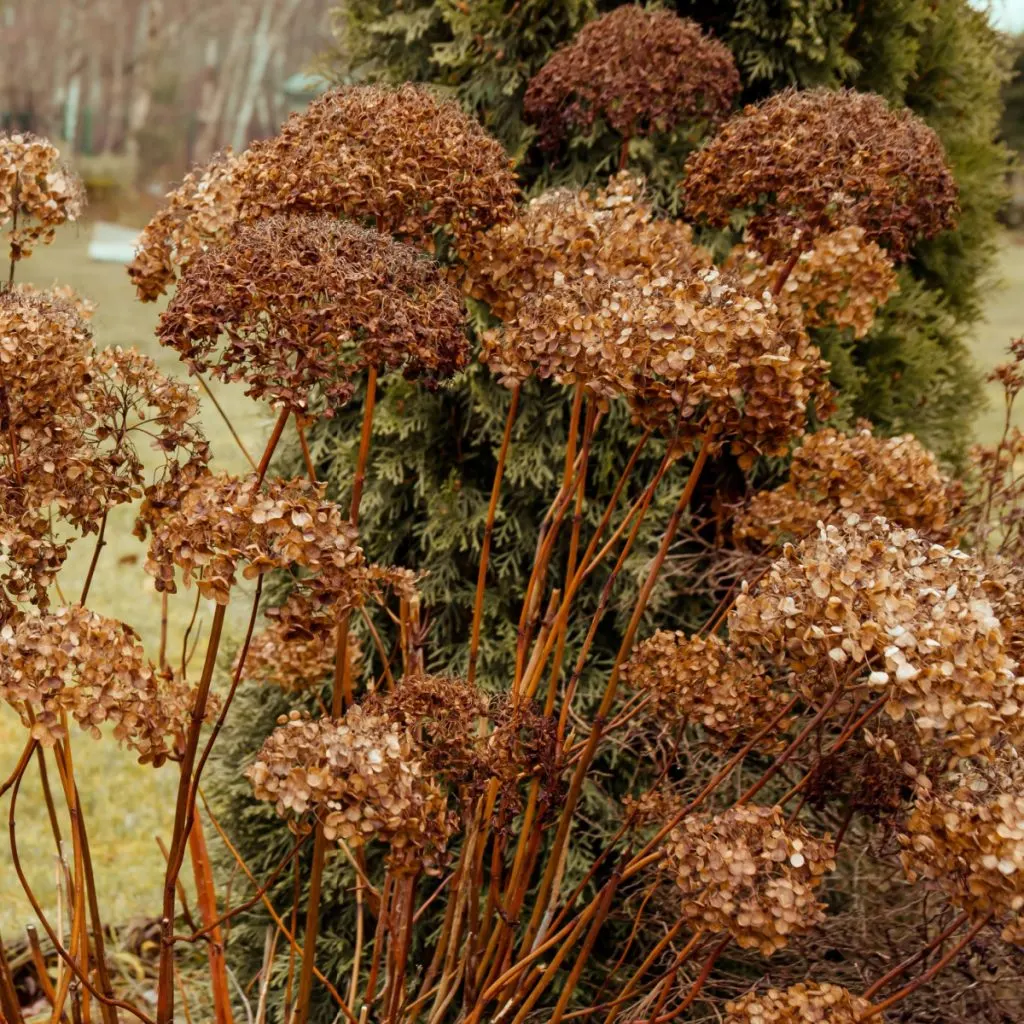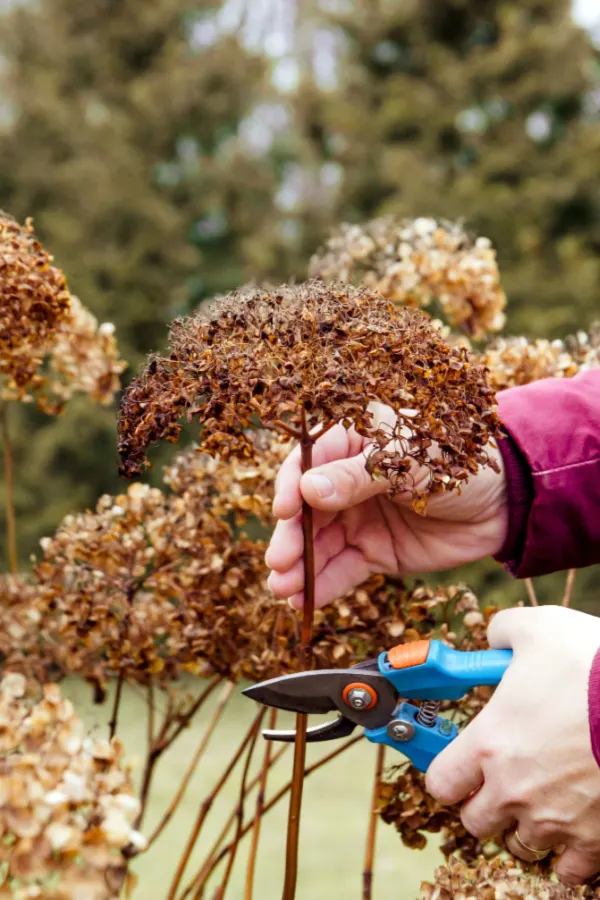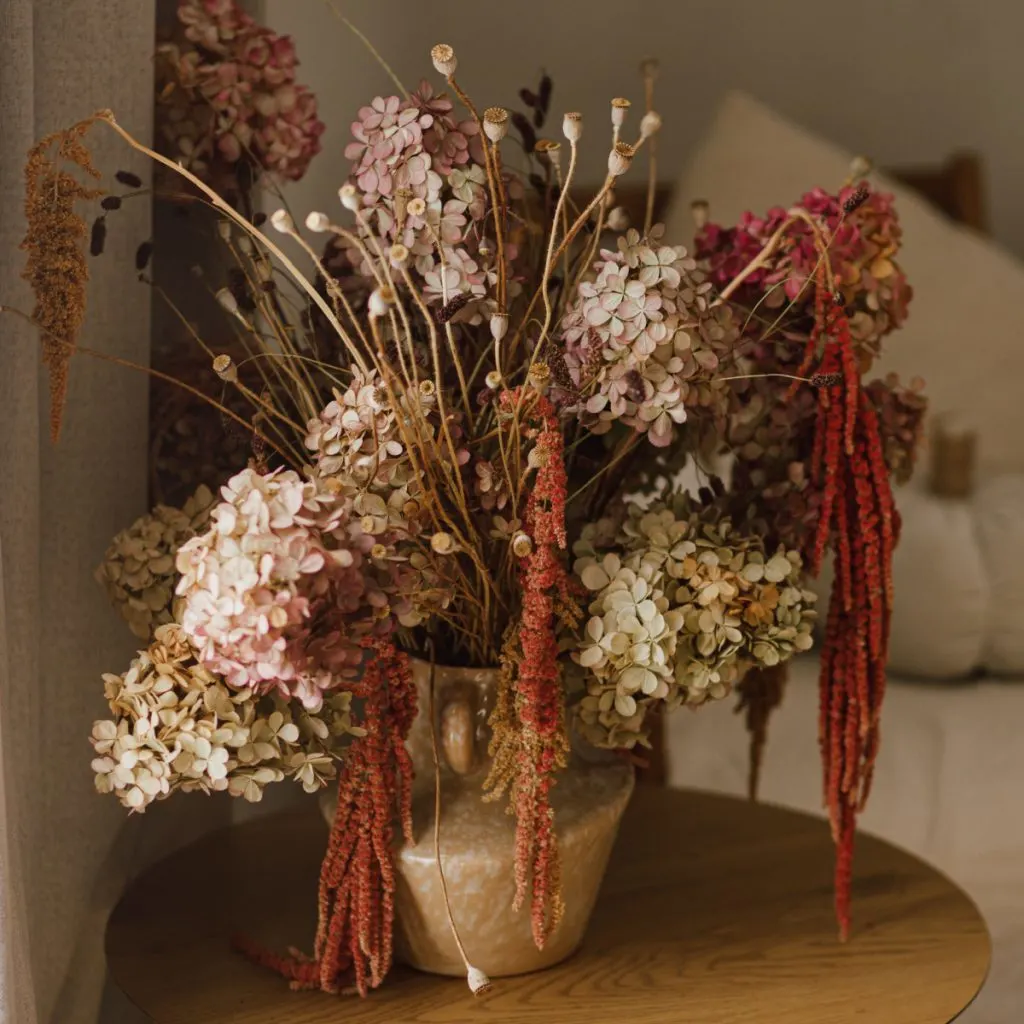One of the biggest questions that gardeners ask about their hydrangea in the fall is what to do with the old and fading blooms on their bushes. Or more to the point – should they be cut off or not.
As fall sets in, hydrangea blooms – once vibrant and colorful – begin to fade, drying naturally on their branches. Unlike most perennials, these flowers retain their form and texture even as they dry. One thing is for sure, they certainly give an incredible look to a landscape that can often be quite bare as fall hits full force.
But as winter approaches, many begin to wonder what to do with the remaining blooms. Is it better to leave them on the plant or to remove them before the snow arrives? And, if you do cut them, can it affect next season’s growth?
Believe it or not, the answer to those questions can play a pivotal role in just how well your hydrangea handles winter. And even more, how well it blooms next year!
What To Do With Old Hydrangea Blooms In The Fall – To Cut Or Not To Cut?
So should you cut or leave old hydrangea blooms in place? The good news is that allowing the blooms to remain on the bush poses no risk to the plant itself. Once the blooms have dried and the plant enters dormancy, they no longer use up any of the plant’s resources.
Many gardeners enjoy leaving the dried blooms up all winter because they bring big interest to the winter garden. In stark, snow-covered landscapes, hydrangea blooms really can add a touch of elegance. Especially when frosted over or dusted with snow.
However, while the plant isn’t in danger of losing power or health when leaving blooms on, there are situations where removing them is quite beneficial.
2 Big Reasons To Remove Old Blooms – What To Do With Old Hydrangea Blooms In The Fall
As a general rule of thumb, if you live in areas with a colder and more snowy winter – it is actually better to remove the blooms before winter arrives for two very good reasons. The first is wildlife – and the second is due to the damage that severe winter can bring.

Deer and other wildlife are often attracted to the old blooms during harsh winters. For them, they view the blooms as a potential food source. And when they consume the flowers, they often tear and damage much of the bush as well.
This is especially true for hydrangea varieties that bloom on “old” wood. Old wood is the wood that grew in the previous season. And when animals chew on these branches, they also prune away next year’s buds, potentially reducing or even eliminating the number of blooms the following summer.
And – if you have a lot of snowfall and ice in your area, leaving the old blooms on can spell trouble as well. That is because as branches get weighted down, they can split and break. Also injuring old wood and next year’s blooms.
To avoid these risks in colder climates, deadheading the old blooms before the first snow flies really is the best course of action.

How To Safely Remove Old Hydrangea Blooms In The Fall
If you do choose to remove the blooms, it’s important to be precise and gentle with your pruning. Avoid cutting into the wood of the branches. Not only can it remove next year’s blooms if you cut the old wood, pruning also stimulates new growth, which can be harmful to the plant in late fall as it approaches dormancy.
To safely remove the blooms, it’s best to let the blooms dry naturally on the plant. This typically means waiting until after the first frost, when blooms are fully dried and the plant has entered dormancy.
When pruning, always use clean, sharp pruners to make precise and clean cuts. Dull pruners can damage the stem and increase the risk of infection as well. It’s vital at this point to only prune the bloom. Affiliate Link: 8″ Professional Sharp Bypass Pruning Shears
Locate the base of each bloom and cut just below it, leaving the branch itself intact. This approach ensures that only the flower is removed without impacting any potential buds for next season. After cutting, you can certainly put the stems and old flowers in your compost pile – but many gardeners like to preserve the blooms for all kinds of winter decor. And, as you will see below, it’s easy to do!
How To Save Hydrangea Blooms – What To Do With Old Hydrangea Blooms In The Fall
If you’re interested in preserving hydrangea blooms for dried arrangements, there’s a simple method that works wonders to help them maintain their color and structure:
Cut the Blooms: Allow the blooms to partially dry on the bush. Then, use pruners to cut the stems about 12-14 inches long. Remove any leaves from the stems as they will drop off much faster than the dried blooms.
Put The Stems In Water: Place the cut stems in a vase with just enough water to cover about ¼ to ½ of each stem. While it may seem odd to use water after they are no longer fresh, this method allows the blooms to dry slowly. This, in turn, helps preserve their color and delicate petal structure.
Finish by putting the vase in a cool, shaded area of your home, away from direct sunlight. Sunlight will also drain the color much faster from the blooms. The drying process typically takes two to three weeks. Once the blooms have fully dried, they’re ready to use in wreaths, bouquets, or simply displayed in a vase as they are.
Don’t Forget To Winterize Your Hydrangeas
Beyond cutting off the old hydrangea blooms before winter, there are a few other things you can do for your bushes to help them through the cold months.
First and foremost, it’s always a good idea to add a layer of mulch around the base of the plant after the first frost. This helps insulate the roots and retains moisture, giving your plants a better chance of thriving through cold months.
If you happen to live in an extremely cold climate, you can also wrap the plant with burlap. This will help to protect it from strong winds and extreme temperatures. In these areas, adding extra mulch or straw around the base for insulation will help protect them as well.
Here is to getting those old blooms off of your hydrangeas before winter – and to having bigger and better blooms next summer! For more on hydrangeas, check out our article: When To Fertilize Hydrangeas – How To Get Big Blooms From Your Hydrangea Bush.
Happy Gardening, Jim & Mary.
Old World Garden Farms
Jim and Mary Competti have been writing gardening, DIY and recipe articles and books for over 15 years from their 46 acre Ohio farm. The two are frequent speakers on all things gardening and love to travel in their spare time.
As always, feel free to email us at thefarm@owgarden.com with comments, questions, or to simply say hello! You can sign up for our free email list in the subscribe now box in the middle of this article. Follow us on Facebook here : OWG Facebook. This article may contain affiliate links.



